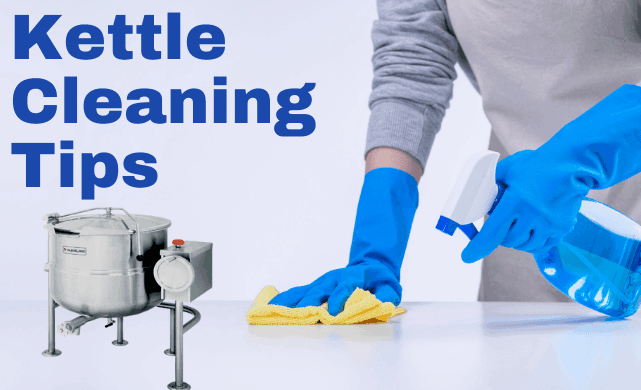A commercial kettle is an ideal for any application that needs to prepare large amounts of soups, sauces, or pastas quickly. In institutional cooking, kettles can even be used to prepare large volumes of coffee or to reheat prepared foods that are bagged, like prepared scrambled eggs. With size ranges from 3 gallon countertop models all the way up to 100-Gallon Twin Unit Kettles, there is a kettle to fit most any operation.
In comparison to most other types of foodservice equipment like ranges or ovens, and even commercial griddles, commercial kettles have a large cooking surface because the entire interior of the kettle has potential for food contact. Keeping your kettle clean both inside and out is important to keep the kettle operating efficiently and for food safety and quality. Here are some cleaning tips to incorporate in your commercial cooking equipment maintenance routine.
1. Clean your kettle as soon as possible, ideally while the kettle is still warm.
2. Scrape the interior and flush out any food residue.
3. With a sponge, cloth or plastic brush, thoroughly clean the kettle interior from top to bottom.
4. Rinse the kettle and all draw-off valve parts carefully with hot water, then drain completely.
5. Before use, it is recommended that your kettle should be sanitized.
6. Clean the front and sides of the kettle with a damp cloth and use a stainless steel cleaner for shine.
The kettle surface can easily be damaged by the sharp edges of metal cooking utensils like spatulas, or ladles. Heavy metal scrubbers, wire brushes and steel wool pads should be avoided when cleaning your kettle so that you reduce the chance of scratching or nicking the surface.
For routine cleaning, use a mixture of hot water and soap or an appropriate detergent. After each cleaning, be sure to rinse and drain the kettle completely. For difficult cleaning situations, soaking and then scrubbing with a non-metal kettle brush, sponge, plastic kettle scraper or spatula will usually remove food product that is stuck to the kettle surface. Never use abrasive materials that can leave scratches in the surface of the kettle. Any scratches in the surface become a location to harbor bacteria and may leave your kettle unusable. Finally, whenever you sanitize your kettle with a chlorine product, be sure that you do not leave the chlorine in contact with the stainless steel for more than ten minutes. Leaving chlorine sanitizers on the stainless steel surface for periods longer than ten minutes can cause pitting and corrosion to the surface and creating a place for bacteria to grow.
Depending on the hardness level and the mineral content in your water supply, mineral deposits can build up on the surface of your kettle. To remove the mineral deposits or any film left from hard water, use a deliming agent. Once your completed with this process, you need to thoroughly rinse and drain the kettle before cooking with it again. Be sure to use a deliming agent that is safe for cooking equipment. Using a solution that is not appropriate for cooking equipment could etch the surface and render your kettle unusable.
